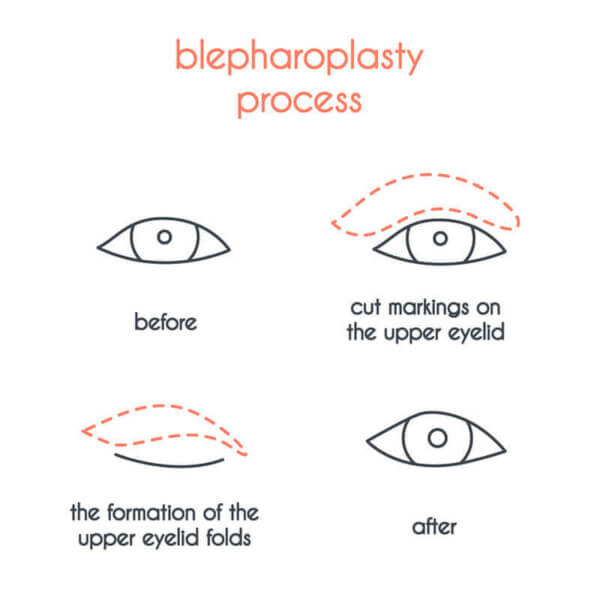As you age, the skin and muscles of your eyelids and eyebrows may sag and droop. You may get a lump in the eyelid due to normal fat around your eye that begins to show under the skin. Excess skin on your upper eyelid can block your central vision (what you see in the middle when you look straight ahead) and your peripheral vision (what you see on the sides when you look straight ahead). Your forehead might get tired from trying to keep your eyelids open. The skin on your upper eyelid may get irritated. Loose skin and fat in the lower lid can create “bags” under the eyes that are accentuated by drooping of your cheeks with age. Many people think these bags look unattractive and make them seem older or chronically tired. Upper Eyelid Blepharoplasty (eyelid surgery) can help correct these problems. Patients often refer to this surgery as an “eyelid tuck” or “eyelid lift.” Please know that the eyelid itself may not be lifted during this type of surgery, but instead the heaviness of the upper eyelids is usually improved.

Ophthalmologists (eye surgeons) call this surgery “blepharoplasty.” In upper eyelid blepharoplasy the ophthalmologist may remove or change the position of skin, muscle, and fat of the upper eyelid(s). The
ophthalmologist will put sutures (stitches) in your eyelid to close the incision (cut). The incision is made in your eyelid’s natural crease.
There are several options for anesthesia to make you comfortable during surgery. Most blepharoplasties are done with local anesthesia (medicine injected around your eye to numb the area). You may also be sedated (relaxed or put to sleep) by medicine from a needle in your arm or pills taken before surgery. Less commonly, or if eyelid surgery is combined with other surgery, you may be given a deeper type of anesthesia that makes you unconscious for the surgery (general anesthesia). Your ophthalmologist will discuss which type of anesthesia seems right for you, and an anesthesia specialist may be involved.
Many people find that blepharoplasty helps correct their eyelid problems. But how much it helps depends on factors that include your symptoms, eyelid structure, appearance, goals, and ability to adapt to changes.
What Are the Benefits of Blepharoplasty?
- Improved peripheral vision (to the sides) and when looking up. You may be able to relax your forehead since you will not rely as much on those muscles to keep your eyes open.
- Removal of dark under-eye circles. With the removal of excess fat under your eyes and repositioning of the fat under your eyes, you can eliminate dark circles and overall soften your appearance.
- A more youthful and rested appearance. The periorbital area can be rejuvenated to create an alert look with open eyes for patients, which creates a youthful, refreshed look.
- Reduced forehead discomfort from muscle straining by lifting sagging skin in the eyelid area. Removing excess skin can help give relief to people who feel as if their eyelids are heavy due to the skin weighing down on the eyelids and eyelashes. The occurrence of muscle strain in the forehead causes the wrinkles on the forehead to over-activate, and this leads to headaches.
- Blepharoplasty does not correct all vision problems. For instance, you will not be able to read printed words more clearly just because you had blepharoplasty. Talk with your ophthalmologist about other ways to improve vision such as with eyeglasses, contact lenses, cataract surgery, or LASIK surgery.
What Can I Do Instead of Blepharoplasty?
- You may decide to do nothing. Excess skin, muscle, and fat around your eye will not go away, but might not bother you enough to do something about it.
- You may be able to have a different type of surgery that will lift your eyebrows. Talk with your ophthalmologist about other surgery options.
- There are other treatments and procedures to improve the appearance of lower eyelids. For instance, you could have Botox injections, filler injections, laser treatment, or a chemical peel. Talk with your ophthalmologist about these and other choices.
Blepharoplasty treatment in Jacksonville, NC
If you’re experiencing symptoms of blepharoplasty, contact the Office Eye Park Center in Jacksonville, NC, for relief. Our expert team of eye doctors and ophthalmologists brings specialized experience.
We can help you and your family with a wide range of eye concerns. Contact Office Park Eye Center in Jacksonville, NC for an appointment today!
